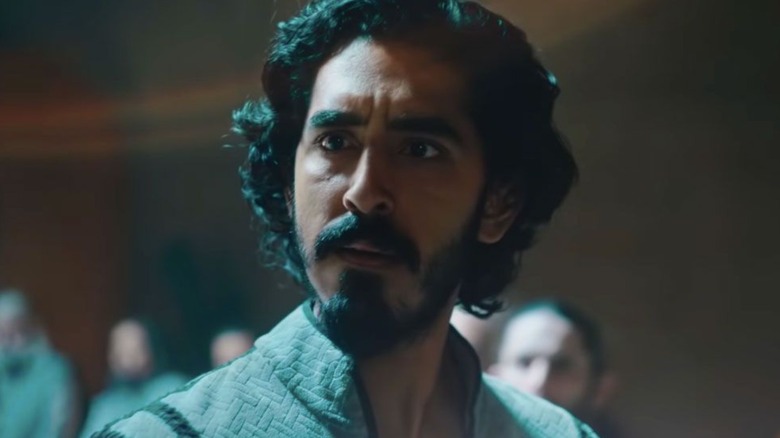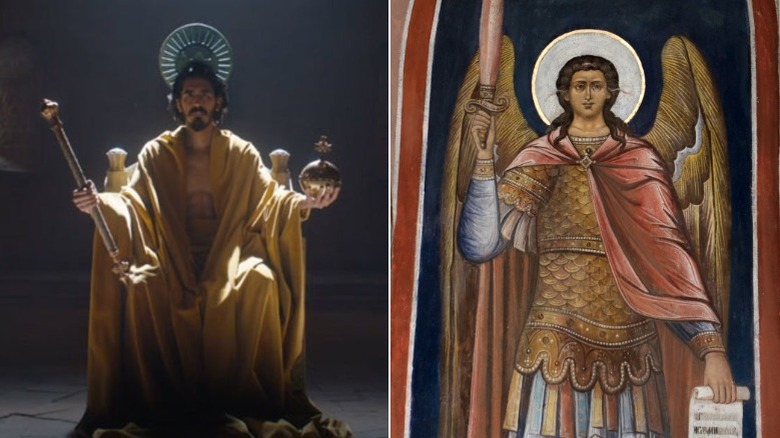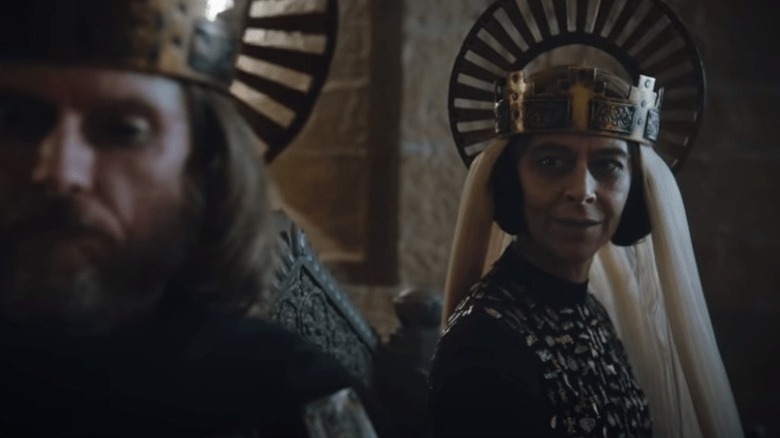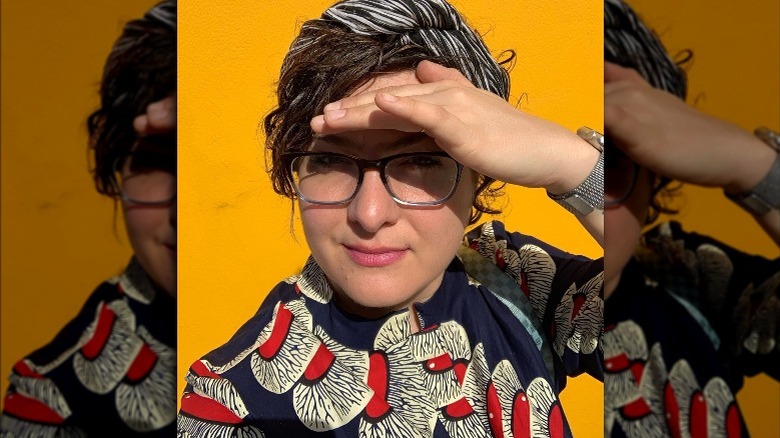What You Don't Realize About The Costumes In The Green Knight
The genre of Arthurian adventure has been an enduring one in Western fiction for centuries, ranging from heady accounts of wartime valor to eerie and fantastical folktales. It has also been a fruitful department of cinemas both British and American since, quite literally, the medium's inception: As early as 1904, Edwin S. Porter was already adapting the quest for the Holy Grail to screen (via TCM), and the number of Arthurian films to have come out since then is overwhelming. Yet many of those films have conformed to the template of "grounded" historical fiction and overlooked the potential for magic, extravagance, and extolment of pagan mythology in the assorted legends of King Arthur's Britain.
"The Green Knight" is coming to change that. Directed by David Lowery of "A Ghost Story" and "Pete's Dragon" fame, the newest historical fantasy film from A24 is committing fully to capturing the eeriness of its source material, the 14th-century epic poem "Sir Gawain and the Green Knight" — an Arthurian allegory full of such unfettered high-fantasy elements as giants and talking animals. Since posters and trailers for the movie began to circulate last year, fans of A24, Lowery, and star Dev Patel have been marveling at the visual and narrative grandeur promised by them, as well as the stunning density of small details that attest to the thoroughness of Lowery's vision. One of those details can be found in the costumes, and, specifically, the headpieces worn by several characters.
The crowns in The Green Knight evoke halos in medieval paintings
Most medieval films operate by a set of unspoken rules when it comes to the visuals and iconography of the period. One of those rules is that crowns must be of the "open crown" or circlet type, metal rings with no overhead elements and minimum adornment aside from the stone and metalwork around the ring — the better to set them apart from the "closed crowns" that became the norm during the modern period (via RachaelDickzen.com).
That's the first rule "The Green Knight" breaks, a fact that has been readily apparent since the first day of marketing. The movie's most iconic image, emphasized in posters and promotional images, is that of Sir Gawain (Patel) wearing a crown adorned with a large sun-like vertical halo. The unique beauty of the headpiece, which the trailer reveals to also be worn by King Arthur (Sean Harris) and Queen Guinevere (Kate Dickie), contributed greatly to the heralding of "The Green Knight" as a different Arthurian epic from what we usually get.
What's interesting about the halo crown is that, besides looking unique, it directly evokes what appears to be one of the film's main sources of visual inspiration: medieval paintings. In both Byzantine and Roman Catholic traditions, the aura-style halo was used to visually highlight figures of great eminence — yet it was all but abandoned by painters following the rise of realist art (via Britannica), of which film language is a direct descendant. The retrieval of that tradition in "The Green Knight" is, therefore, momentous, not to mention full of symbolic meaning.
There is plenty of meaning to the halo image in The Green Knight
Of course, even taking it as an homage to medieval art, the decision to supply the characters of "The Green Knight" with halos probably doesn't come down to such arbitrary reasoning as "It's in old paintings, so let's throw it in." There is a deeper significance to that choice.
First off, it's interesting that the characters who "wear" the halos in "The Green Knight" are not angels, saints, or other eminent Christian figures. That's overwhelmingly the case in Medieval art; even Justinian, the powerful Byzantine emperor who's often depicted with a halo around his head, is considered a saint in the Orthodox Church. Sir Gawain, conversely, is merely a knight, and Arthur and Guinevere are but earthly rulers.
This points to two things: Number one, that "The Green Knight" understands the authority of medieval kings was largely derived from the Christian faith, and will probably have some interesting questions to raise about the relationship between that faith and pagan folklore. Number two, that the heavy religious symbolism of "Sir Gawain and the Green Knight," which has often been interpreted as a parable for the relationship between Christ and a believer, is not lost on Lowery.
Moreover, as explained in the blog Medieval Iconography, the halos functioned as a sort of educational code: "[T]hese halos were in fact signals to the viewer that someone of great importance was inhabiting the artwork," the site noted. "It became a hunt ... to identify those depicted and to understand why they were beautified with that specific type of halo." Therefore, it's worth asking why the halos in "The Green Knight" are of the sunburst variety, more commonly seen in classical depictions of Greek and Roman gods (via Alberti's Window).
The Green Knight's costume designer knows a thing or two about attention to detail
It's no surprise that "The Green Knight" boasts such an impressive, thought-provoking costume design. After all, the wardrobes in the movie were overseen by the brilliant Malgosia Turzanska, who previously collaborated with David Lowery in 2013's "Ain't Them Bodies Saints," and has been rising rapidly in the industry since then.
In addition to Sir Gawain's halo crown, the Polish-born Turzanska has recently been responsible for such memorable and varied looks as the hooded vest-baseball hat combo that sums up Joe (Joaquin Phoenix)'s world-weary personality in "You Were Never Really Here," the neo-Western stylings of "Hell or High Water," and the luxuriously comfy coats and sweaters worn by Julianne Moore and Greta Gerwig in "Maggie's Plan." She was also nominated for a Costume Designers' Guild Award for her work on Season 1 of "Stranger Things."
In an interview with Matthew Toffolo's Summary at the time of "Maggie's Plan," Turzanska detailed the intense research process that goes into her work, and which no doubt informs the deeper historical and symbolic significance of "The Green Knight'"s costumes. "I study the specifics of the period and environment where the story takes place, which includes reading books, looking at photos, going to museums, watching movies — whatever is available," she said. "That's one of my favorite stages, because you come across so many unexpected tidbits that gradually shape the design." By the looks of it, "The Green Knight" will offer viewers an invaluable opportunity to dive into such tidbits themselves.



